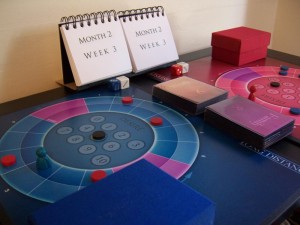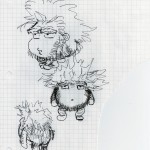A long while ago I stopped posting when I decided I wasn’t getting enough cold hard coding done. After a lot of cold hard coding, I’m back to talk about Bad Bones. Bad Bones is a flash based real-time strategy game that is my first attempt at the RTS genre the way I see it. It still needs work, but it’s doing well.
Bryson is still working on unit art, but here are a couple sketches I sent over to give him an idea of what I was going for with the game.
They’re called Boman and they like to eat and have babies. Stay tuned for more art and the Boman backstory.
I’ll be demoing my early version of Bad Bones at the Independent Game Conference West in sunny Los Angeles (Marina Del Rey) this Thursday and Friday (November 5th and 6th, 2009). If you’re around, gimme a holler and wish me luck on finding a bag of cash to fund my game.
Now I wish to direct your attention to some impressive figures! I expect that I can deliver good performance on map sizes at least as big as 1600×1200, and perhaps as large as 3200×2400. Dimensions like that are generally thought to be impossible in flash, but I tell you it can be done. My proof is that I have seen it! Though it was at about 15fps…Still, it can happen.
I can get in 1000 units if I’m okay with 15fps on a 1600×1200 map currently. After some house-cleaning I expect to run a solid 30 fps with 500 units on a 1600×1200 map and of course I’ll aim for higher.
Bad Bones represents years of pondering over the RTS genre. I might say that the first time I became a hardcore fan of a game was when I got into Warcraft. It was right around the time that Warcraft 2 was coming out that I found out about the series from a kid named Raphael in my 6th grade class. His description gave me a blind faith in its excellence, and at this crucial time in my gaming experience, I was not disappointed. My family had just recently purchased our first computer and Warcraft and Warcraft 2 were an immensely gratifying experiment in PC gaming for my brother and I.
However the suspension of disbelief perpetuated by the fantastic booklet art and its pages of story, the in-game text, cut-scenes, and characters could not last forever. Warcraft 2 was my first online multiplayer experience and I became immediately aware that the name of the game was micromanagement and rushing. The best players weren’t strategists or tacticians, they were factory foreman that knew how to pump out a basic unit fast and deliver it to the enemy encampment. Continue Reading…
























